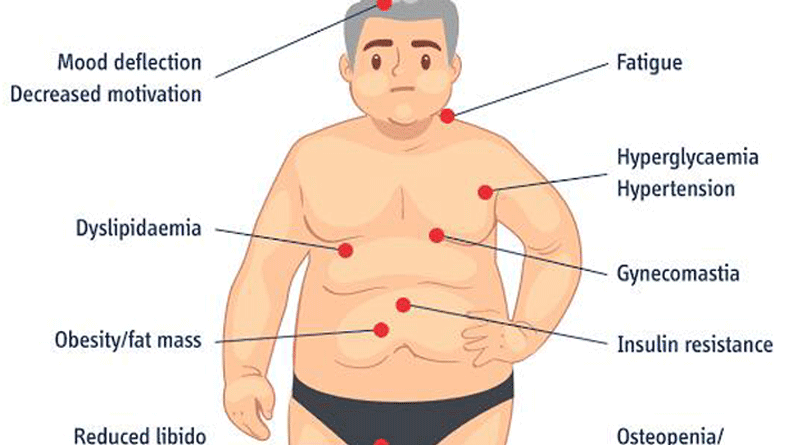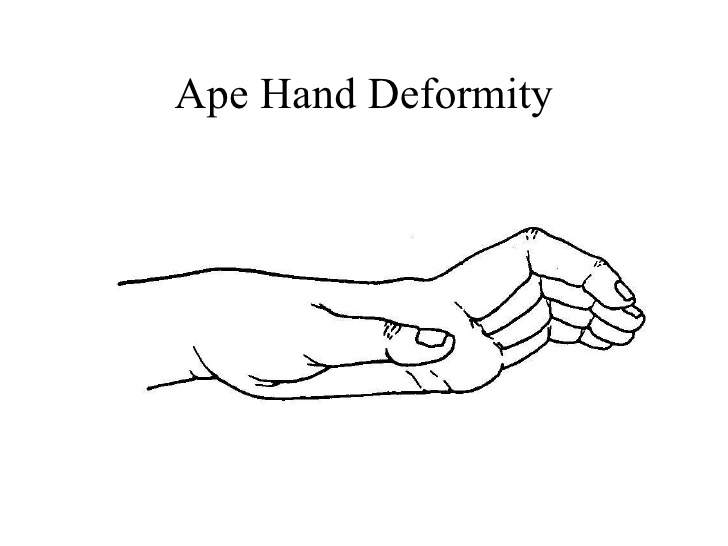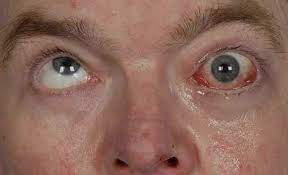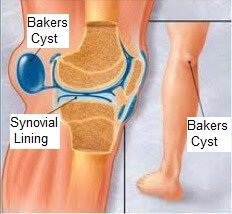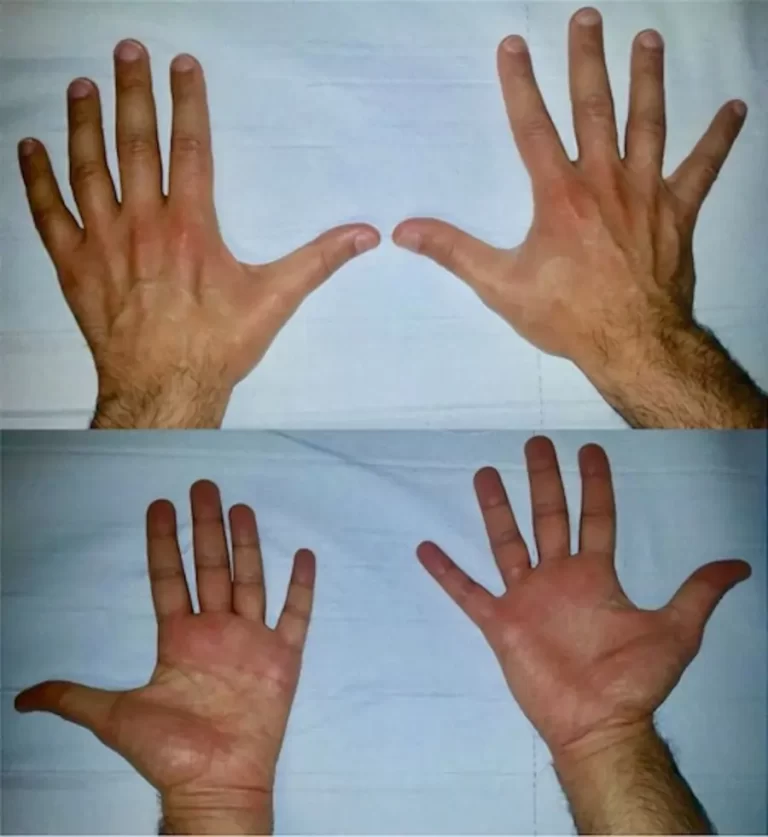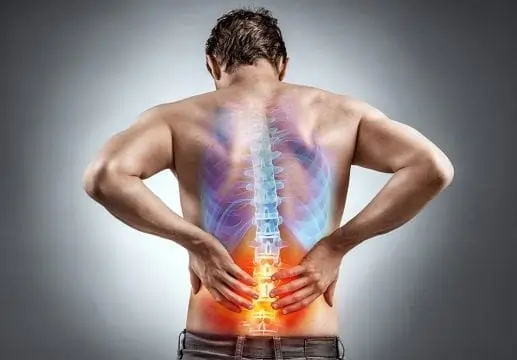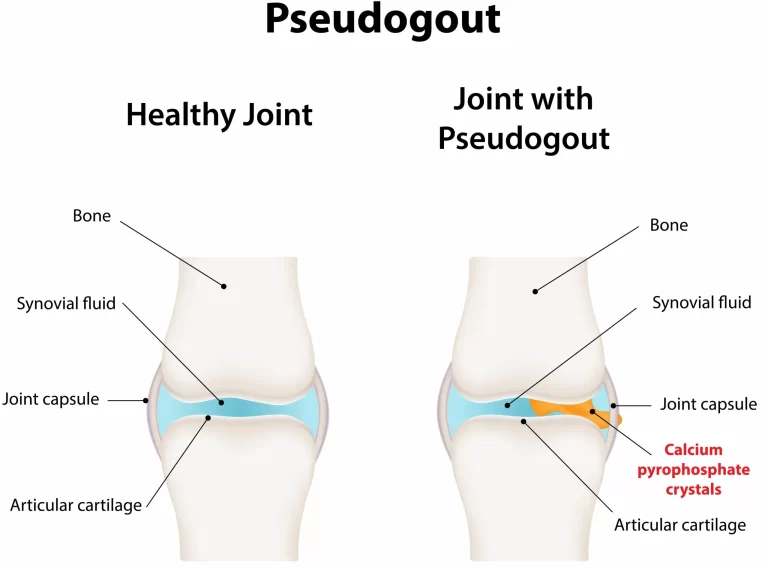Hypogonadism
Hypogonadism, or gonad deficiency, happens when the sex glands generate little or no sex hormones. Most cases of hypogonadism condition respond well to appropriate medical treatment.
The sex glands, also known as gonads, are primarily the testes in men and the ovaries in women. Sex hormones help control secondary sex characteristics, like breast development in females, testicular development in males, and pubic hair growth. Sex hormones also play a vital role in the menstrual cycle and sperm production. Hypogonadism is also identified as low serum testosterone and andropause when it happens in men.
Table of Contents
What are the types of hypogonadism?
There are mainly two types of hypogonadism: primary and central.
Primary hypogonadism
- Primary hypogonadism means that a person does not have enough sex hormones in the body because of a problem in the gonads.
- The gonads are still receiving the message to generate hormones from the brain, but they are not able to generate them.
Central (secondary) hypogonadism
- In this type of hypogonadism, the problem lies in the brain. The hypothalamus and pituitary gland, which control the gonads, are not working perfectly.
What are the causes of hypogonadism?
The causes of primary hypogonadism involve:
- Autoimmune disorders, like Addison’s disease and hypoparathyroidism
- Genetic conditions, such as Turner syndrome and Klinefelter syndrome
- Severe infections, specifically mumps including the testicles
- Liver and kidney diseases
- Undescended testes
- Hemochromatosis, which happens when the body absorbs too much iron
- Radiation exposure
- Surgery on the sexual organs
Central hypogonadism can be because of:
- Genetic diseases, such as Kallmann syndrome (abnormal hypothalamic development)
- Infections, including HIV
- Pituitary disorders
- Inflammatory diseases, involving sarcoidosis, tuberculosis, and histiocytosis
- Obesity
- Rapid weight loss
- Nutritional deficiencies
- Use of steroids or opioids
- Brain surgery
- Radiation exposure
- Injury to the pituitary gland or hypothalamus
- A tumor in or near the pituitary gland
What are the symptoms of hypogonadism?
Symptoms that can appear in women involve:
- Lack of menstruation
- Slow or absent breast growth
- Hot flashes
- Loss of body hair
- Low or absent sex drive
- Milky discharge from breasts
Symptoms that can appear in men involve:
- Loss of body hair
- Muscle loss
- abnormal breast growth
- The decreased growth of the penis and testicles
- Erectile dysfunction
- Osteoporosis
- low or absent sex drive
- Infertility
- Fatigue
- Hot flashes
- Difficulty concentrating
How is hypogonadism diagnosed?
The doctor will do a physical exam to confirm that the sexual development is at the proper level for the age. They can test muscle mass, body hair, and sexual organs.
Hormone tests
- If the physician thinks a person might have hypogonadism, they will first check the sex hormone levels.
- A person will need a blood test to check the level of follicle-stimulating hormone (FSH) and luteinizing hormone.
- The pituitary gland makes these reproductive hormones.
- The person will have the estrogen level tested if the patient is female.
- If a person is male, the person will have the testosterone level tested.
- These tests are generally drawn in the morning when the hormone levels are highest.
- If a person is male, the physician can also order a semen analysis to check the sperm count.
- Hypogonadism may decrease and reduce sperm count.
- The physician can order more blood tests to help confirm a diagnosis and find out any underlying causes.
- Iron levels may affect the sex hormones.
- For this reason, the physician can check for high blood iron levels, typically seen in hemochromatosis.
- The physician can also wish to measure the prolactin levels.
- Prolactin is a hormone that elevates breast development and breast milk production in females, but it is present in both genders.
- The physician can also check the thyroid hormone levels. Thyroid problems may cause symptoms similar to hypogonadism.
Imaging tests
- Imaging tests may also be useful in diagnosis.
- An ultrasound uses sound waves to generate an image of the ovaries and check for any problems, involving ovarian cysts and polycystic ovary syndrome.
- The physician can order MRIs or CT scans to check for tumors in the pituitary gland.
What are the treatments for hypogonadism?
Treatment for female hypogonadism
- If the patient is female, the treatment will include improving the number of female sex hormones.
- The first line of treatment will probably be estrogen therapy if a person had a hysterectomy.
- Either a patch or pill may administer supplemental estrogen.
- Because elevated estrogen levels can improve the risk of endometrial cancer, the person will be given a combination of estrogen and progesterone if a person has not had a hysterectomy.
- Progesterone may lower the risk of endometrial cancer if the person is taking estrogen.
- Other treatments may target specific symptoms. If a person has a reduced sex drive, a person can receive low doses of testosterone.
- If a person has menstrual irregularities or trouble conceiving, a person can receive injections of the hormone human choriogonadotropin or pills containing FSH to trigger ovulation.
Treatment for male hypogonadism
Testosterone is a male sex hormone. Testosterone replacement therapy is used in a wide range of treatments for hypogonadism in men. A person may get testosterone replacement therapy by:
- Injection
- Patch
- Gel
- Lozenge
- Injections of a gonadotropin-releasing hormone can trigger puberty or increase sperm production.
Treatment for hypogonadism in men and women
Treatment for males and females is similar if the hypogonadism is because of a tumor on the pituitary gland. Treatment to shrink or remove the tumor may involve:
- Radiation
- Medication
- Surgery
Physiotherapy treatment
Normally exercise therapy is not suggested in this condition because maybe elevate the symptoms. some light weight exercises and basic aerobic exercises can help people. The exercise program combined 20 to 30 minutes of aerobics, 10 minutes of whole-body stretching, 15 to 20 minutes of strength exercises, and then another 10 to 20 minutes of aerobics. At baseline, the exercisers and non-exercisers had levels equal levels of free testosterone (281.9 vs 277.1 ng/dL).
Aerobic exercise
Benefits
Aerobic exercises help build strength in large muscle groups, keep up the blood pumping, and also, help strengthen the heart and lungs. Other benefits of aerobic exercises are:
- Help reduce cholesterol.
- Decrease the risk of a heart attack.
- Decrease the risk of type 2 diabetes.
- decrease the risk of certain cancers breast, colon, etc.
- Helps improves bone density for patients with osteoarthritis or other rheumatic conditions.
- Decrease pain and swelling due to arthritis.
- Increase immune function.
- Decrease blood pressure.
- Helps in weight loss.
- Build endurance and stamina.
- Tones the muscles and improves posture.
- Increase balance.
- Helps reduce anxiety.
- Reduce symptoms of depression.
- Increase balance.
- Improved mood.
- Helps reduce stress through sleep and mood-regulating benefits.
- Decrease the risk of dementia and may improve cognition.
Running/jogging
- Start gently with alternate walking and running for one to two minutes at a time.
- Primarily do short sessions twice a week, and then progress to 30–40 minutes, 2 or 3 times per week, as the strength increases.
Walking
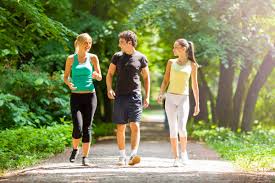
- Walking is the greatest aerobic exercise because it is easy to perform and may be done anywhere.
- Do brisk walking for 5 minutes before and after work and at lunchtime or simply take long walks.
- Monitor the steps, a person may set a target of 10,000 steps per day and work out the goal by adding 500 steps daily for half an hour to one hour thrice a week.
Dancing
- Dancing may be done while listening to your favorite music in the private room. It may be done for 15 minutes or for an hour, 3 or 5 times per week.
Jump rope
- Begin with a goal of a 20-minute workout thrice a week. Progress by improving the no of jumps and the time thus making it more difficult.
Stairsteps
- Start with standing upright in front of the stairs, do not lean on the handles.
- Then put the foot on the step up and then place it back down.
- Look forward while using the muscles.
- Start at a slow pace, and then improve the speed thus improving the intensity of the exercise.
- Then slow back. Do it for 10–30 minutes, 3 times per week.
Swimming
- Swimming is a great no-impact workout.
- Start with laps using one stroke, add more like the breaststroke, the backstroke, or advanced one in the essence of butterfly swimming for 20–30 minutes thrice a week increasing the duration by 10 minutes each week, and take rest between laps. Do not swim lonely or without a lifeguard.
Stationary bike
- Adjust the bike to the proper height.
- Begin with a slow pace for 5–10 minutes (warm-up), and then improve the pace for an hour thrice a week until it is a bit challenging.
Jump squat
- Start with standing straight with the feet apart at shoulder’s width.
- Move into the squat position. Utilize a jumping motion, to move up and out of the squat position.
- Upon landing, rapidly move into a squat position and repeat.
Stretching exercise
Side Lunge Stretch

- Keep up the upper body straight and legs apart.
- Then shift the weight in a slow “lunge” to the side over a bend of the knee (not forward, as in a typical lunge).
- The person should feel a stretch along the inner thigh of the other leg, which should be straight as a person push the weight to the bent-knee side. Try to hold it for 10 to 20 seconds on each side.
Calf Stretch
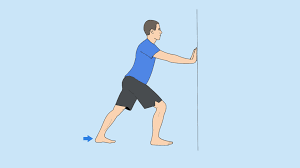
- Initiate with a stand facing a wall a bit more than arm’s length away.
- Keep one foot ahead with a bent knee, and the other one back with a straight knee.
- The feet should point directly forward.
- Using the arms to brace yourself against the wall, keep the belly firm and lean until a person feels the stretch in the calf muscle of the back leg. Try to keep both feet flat. Hold it for 10 to 20 seconds on each side.
Chest and Shoulder Stretch
- A person can perform this sitting or standing.
- Interlace the fingers with bent elbows and put the hands behind the head.
- Move the elbows gently backward and squeeze the shoulder blades together.
- A person can move the hands to the top of the head — or a few inches above the head to affect various parts of the shoulders and chest.
Glute Bridge
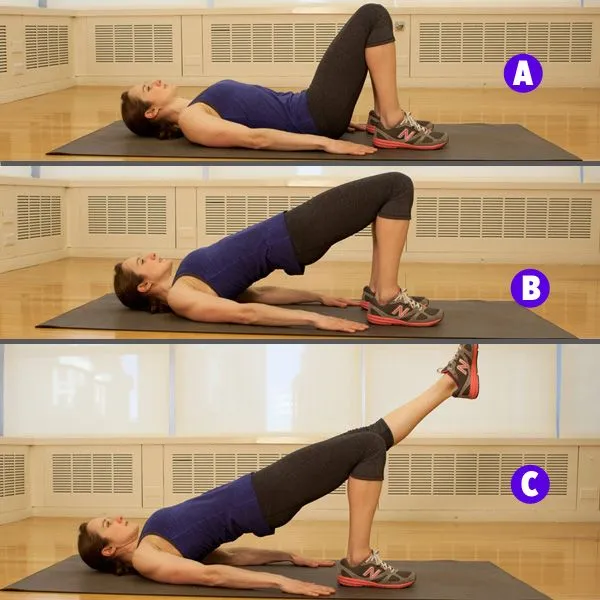
- This one stretches the hip flexors.
- Start with lying on the back with the knees bent and the feet on the floor about hip-width apart.
- Slowly tighten the stomach muscles to help flatten the back and prevent overstretching.
- Then tighten the butt (glute) muscles as a person push the hips up toward the ceiling.
- Hold for ten seconds and repeat.
Standing Quad Stretch
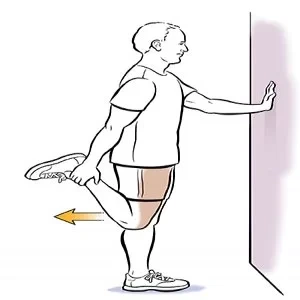
- Start with standing behind a chair with the legs about shoulder-width apart.
- Place one hand on the chair for balance.
- On the other side, lift the foot behind a person and grab it with the free hand, keeping the bent knee pointing straight to the floor.
- Do not bend forward, and try not to lock the knee of the standing leg.
- Pull slowly on the leg until a person feels the thigh stretch.
- Hold it for 20 to 40 seconds.
Cobra

- It stretches the stomach and back muscles.
- Start with lying on the belly with the hands facing forward flat on the floor, and directly under the shoulders.
- Stretch the legs out behind a person and point the toes.
- As a person exhale, lift the chest up and push the hips into the floor.
- Take care not to extend the arms so far that a person lift the hips up.
- Hold the position for 10 to 20 seconds.
Standing Hip Flexor Stretch

- The hip flexors muscles that help a person lift the knees and bend the waist may get tight if a person is a runner or a person sit for long periods.
- put one leg back, keeping it straight or gently bent.
- Try to keep the torso upright and the spine straight.
- Drop the tailbone down toward the floor and tuck the butt forward until a person feels the stretch on the inside thigh of the rear leg.
- Hold for 20 to 30 seconds and then change the legs.
Butterfly Stretch
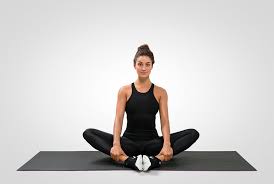
- This one loosens up the inner thighs, groin, hips, and knees.
- Start with sitting on the floor or a mat and bring the feet together so that the soles touch and the knees bend to other sides.
- With a straight spine, grab the feet, then lean gently forward and gently push the thighs down with the elbows until a person feels the stretch along the inner thighs.
- Hold for 10 to 20 seconds.
Standing Hamstring Stretch
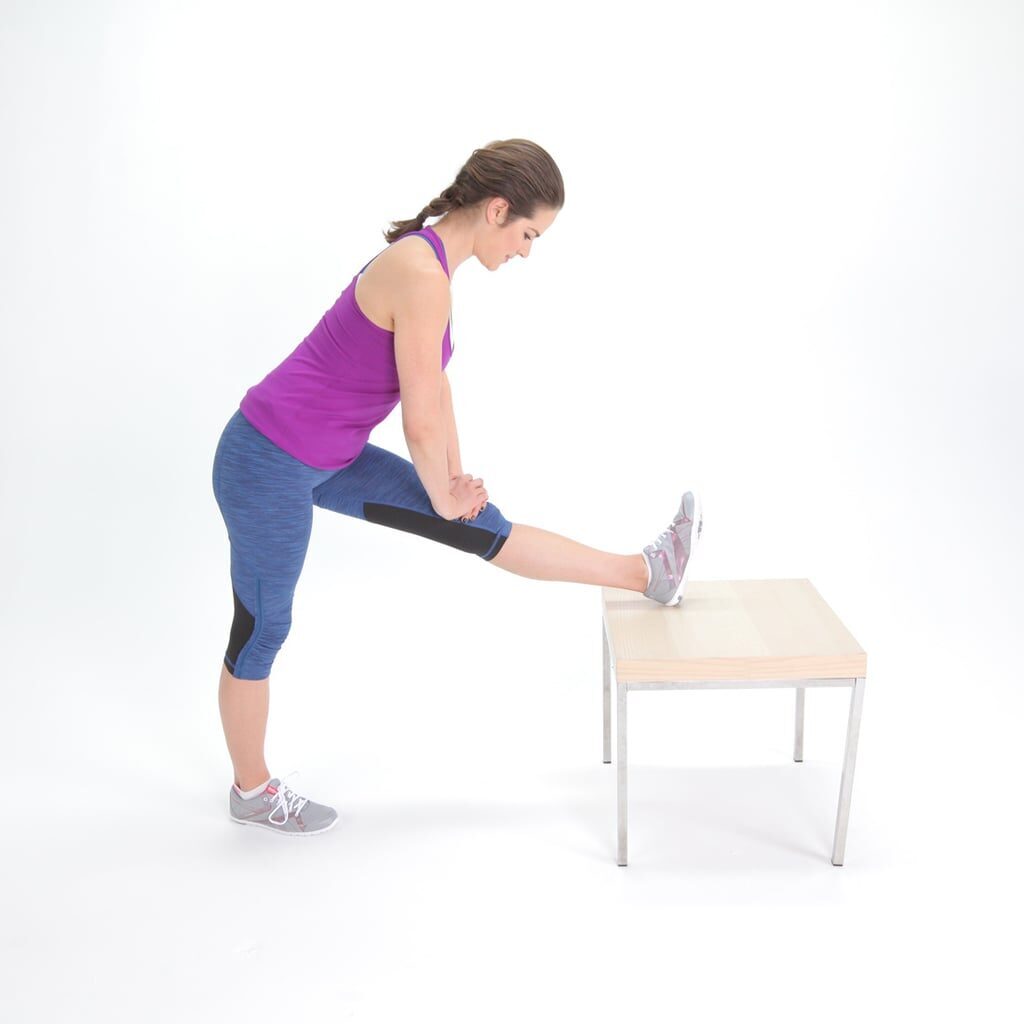
- In a standing position, find some objects to hold for balance.
- Put one straightened leg up on a step or a small table.
- Bend slightly (not beyond the toes) with the opposite knee until a person feels a gentle stretch at the back of the thigh of the raised leg.
- Bend slightly forward from the hips if a person requires more stretch.
- Move gently and evenly, without bouncing.
- Hold it for 10 to 20 seconds and switch legs.
Reclining Figure 4
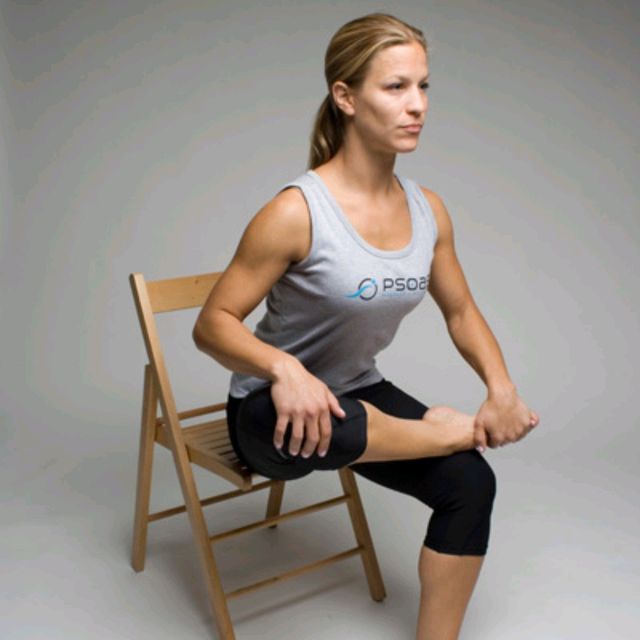
- A person will experience this one in the hips and glutes, and it should release some tension in the lower back.
- Start with sitting on the chair with knees bent and feet flat.
- Cross one ankle over the other thigh and pull them toward the body.
- Try not to force it.
- Utilize gravity and the weight of the legs to get them closer to the body.
- Hold for 10 to 20 seconds and then change legs.
Sideways Neck Stretch

- Start with standing with the feet hip-width apart.
- Tighten the belly and pull the shoulders back.
- With the head slightly forward, gently tilt the ear toward the shoulder on the same side until a person feels a stretch.
- Hold it for about 20 seconds, and gently bring the head back up and do the other side.
- A person may improve the stretch by using the hand on the tilting side slowly pull the head down.
Lying Knee-to-Chest Stretch

- This one reaches the quads, hip flexors, lower back, and hamstrings.
- Lie on the back and slowly pull one knee toward the chest until a person feels a stretch in the lower back.
- Leave the other leg bent if a person has low back pain.
- Otherwise, choose what is more comfortable.
- If straight, a person can add to the stretch by pushing the back of the knee toward the floor.
- Hold it for 30 seconds and then change legs.
FAQ
The doctor will test the blood level of testosterone if the person has signs or symptoms of hypogonadism. Because testosterone levels vary and are usually highest in the morning, blood testing is usually done early in the day, before 10 a.m., possibly on more than one day.
Risk factors for hypogonadism involve type 2 diabetes, obesity, renal failure, HIV, hypertension, chronic obstructive pulmonary disease (COPD), and taking glucocorticoid (steroids), opioid, or antipsychotic medication therapy.
Natural therapies to improve testosterone and estrogen production involve diet and exercise, weight loss, improved sleep, reducing stress, eating hormone-stimulating foods, and taking well-studied supplements.
Furthermore, we observed a trend toward improving the risk of hypogonadism in men with very low vitamin D levels indicating a U-shaped association between vitamin D levels and hypogonadism. With respect to the risk of male hypogonadism, our results recommend optimal serum 25(OH)D concentrations of 82-102 nmol/L.
Ashwagandha has been used for 1000 of years to treat hypogonadism, low libido, and male infertility. The aim of this study is consistent with prior research demonstrating that Ashwagandha increases sperm parameters in infertile men with hypogonadism.

